
Vic is the capital of the comarca of Osona, in the province of Barcelona, Catalonia, Spain. Vic is located 69 km (43 mi) from Barcelona and 60 km (37 mi) from Girona.

The Cathedral of the Holy Cross and Saint Eulalia, also known as Barcelona Cathedral, is the seat of the Archbishop of Barcelona in Catalonia, Spain. The cathedral was constructed from the thirteenth to fifteenth centuries, with the principal work done in the fourteenth century. The cloister, which encloses the Well of the Geese (Font de les Oques), was completed in 1448. In the late nineteenth century, the neo-Gothic façade was constructed over the nondescript exterior that was common to Catalan churches.

The Cathedral of Saint Mary of Burgos is a Catholic church dedicated to the Virgin Mary located in the historical center of the Spanish city of Burgos. Its official name is the Holy Metropolitan Cathedral Basilica Church of St Mary of Burgos.
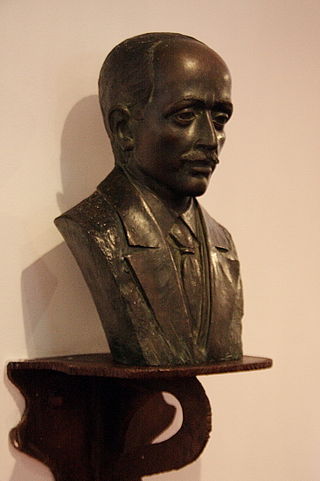
José María Jujol Gibert was a Catalan Spanish architect. Jujol's wide field of activity ranged from furniture designs and painting, to architecture. He worked with Antoni Gaudí on many of his most famous works. Among Jujol's projects are Casa Batlló, Casa Milà, Park Güell, and Our Lady of Montserrat, and among his design styles are Modernisme and Art Nouveau.

The Cathedral of the Savior or La Seo de Zaragoza is a Catholic cathedral in Zaragoza, in Aragon, Spain. It is part of the World Heritage Site Mudéjar Architecture of Aragon.

The Palace of the Generalitat of Catalonia is a historic palace in Barcelona, Catalonia, Spain. It houses the offices of the Presidency of the Generalitat de Catalunya. It is one of the few buildings of medieval origin in Europe that still functions as a seat of government and houses the institution that originally built it.

The Museu Nacional d'Art de Catalunya, abbreviated as MNAC, is a museum of Catalan visual art located in Barcelona, Catalonia, Spain. Situated on Montjuïc hill at the end of Avinguda de la Reina Maria Cristina, near Pl Espanya, the museum is especially notable for its outstanding collection of romanesque church paintings, and for Catalan art and design from the late 19th and early 20th centuries, including modernisme and noucentisme. The museum is housed in the Palau Nacional, a huge, Italian-style building dating to 1929. The Palau Nacional, which has housed the Museu d'Art de Catalunya since 1934, was declared a national museum in 1990 under the Museums Law passed by the Catalan Government. That same year, a thorough renovation process was launched to refurbish the site, based on plans drawn up by the architects Gae Aulenti and Enric Steegmann, who were later joined in the undertaking by Josep Benedito. The Oval Hall was reopened for the 1992 Summer Olympic Games, and the various collections were installed and opened over the period from 1995 to 2004. The museum was officially inaugurated on 16 December 2004. It is one of the largest museums in Spain.
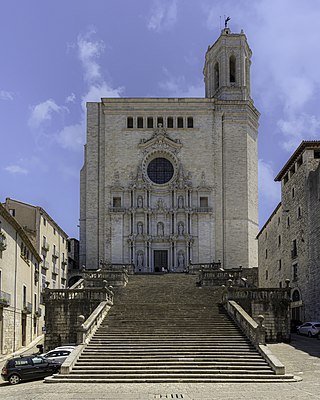
The Cathedral of Saint Mary,, is a Roman Catholic cathedral located in Girona, Catalonia, Spain. It is the seat of the Roman Catholic Diocese of Girona.

Valencia Cathedral, at greater length the Metropolitan Cathedral–Basilica of the Assumption of Our Lady of Valencia, also known as St Mary's Cathedral, is a Catholic church in Valencia, Spain.

Dalmaciode Mur y de Cervelló was a Spanish prelate of the fifteenth century. He served as Bishop of Girona (1415–1418), Bishop of Tarragona (1419–1431), and finally Archbishop of Zaragoza (1431–1456).
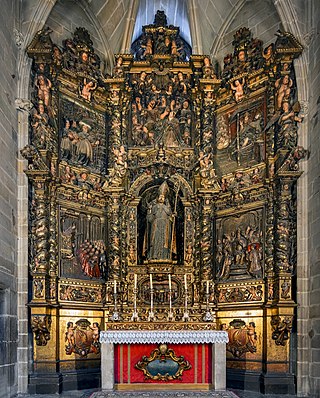
Francesc Santacruz i Artigas was a Catalan sculptor of Baroque works. He was active between 1665 and 1721. From a family of sculptors, he worked in the studio of Pere Serra, which he entered in 1665. It is known that, with Domènec Rovira, he participated in the legal suit that demanded that a separate guild for sculptors be formed, and in 1680 Charles II of Spain allowed the creation of the Cofradía de los Santos Mártires escultores, which allowed sculptors to freely receive commissions for their works and expenses.

Damián Forment was an Aragonese Spanish architect and sculptor, considered the most important Spanish sculptor of the 16th century.

Jaume Huguet was a Catalan painter.

Jaume Cascalls was a Catalan sculptor, born in Berga. He was a representative of the Catalan school of Gothic sculpture. He was married to the daughter of painter Ferrer Bassa, with whom he had a profitable work relationship.
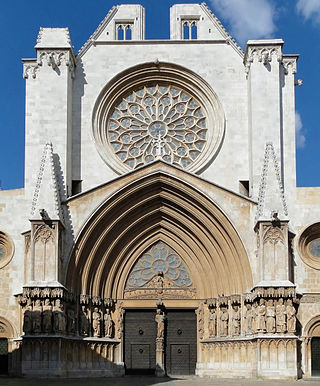
The Primatial Cathedral of Tarragona is a Roman Catholic church in Tarragona, Catalonia, Spain. The edifice is located in a site previously occupied by a Roman temple dating to the time of Tiberius, a Visigothic cathedral, and a Moorish mosque. It was declared a national monument in 1905.

Jordi de Déu was a Catalan Gothic sculptor of Greek origin, born in Messina.
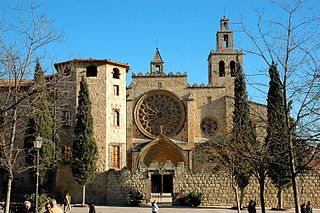
The Monastery of Sant Cugat is a Benedictine abbey in Sant Cugat del Vallès, Catalonia, Spain. Founded in the ninth century, and under construction until the 14th century, it was the most important monastery in the county of Barcelona. Its most notable architectural feature is its large Romanesque cloister.
Pere Blai (1553–1621) was a Spanish architect.

Antoni Gaudí i Cornet was a Catalan architect and designer, known as the greatest exponent of Catalan Modernism. Gaudí's works have a sui generis style. Most are located in Barcelona, including his main work, the Sagrada Família church.
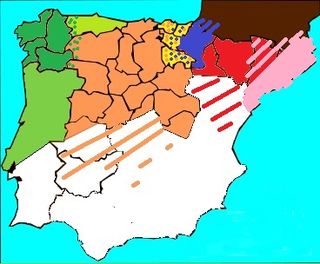
Spanish Romanesque designates the Romanesque art developed in the Hispanic-Christian kingdoms of the Iberian Peninsula in the 11th and 12th centuries. Its stylistic features are essentially common to the European Romanesque although it developed particular characteristics in the different regions of the peninsula. There is no Romanesque art in the southern half of the peninsula because it remained under Muslim rule (Al-Andalus). The examples of Romanesque buildings in the central area of the peninsula are sparse and of the latest period, with virtually no presence south of the Ebro and the Tagus. Most Romanesque buildings can be found in the northern third of the peninsula. Romanesque art was introduced into the peninsula from east to west, so scholars have usually defined regional characteristics accordingly: the "eastern kingdoms" comprising the Pyrenean areas, Catalan Romanesque, Aragonese Romanesque and Navarrese Romanesque, and the "western kingdoms" comprising Castilian-Leonese Romanesque, Asturian Romanesque, Galician Romanesque and Portuguese Romanesque.



















